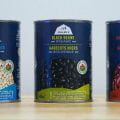Pulses may not be part of your daily diet, but that might be about to change, especially since the United Nations called 2016 the International Year of Pulses. Packed with protein, fibre, vitamins and minerals, pulses are easy to grow—even in our own gardens—and are versatile to cook with. So why have Canadians ignored them for so long? According to Dan Jason, co-author of the new book The Power of Pulses: Saving the World with Peas, Beans, Chickpeas, Favas & Lentils (Douglas & McIntyre, $24.95), our country is a top exporter of pulses, although at home we hardly consume them. In short, we grow pulses for the world to enjoy. “Canada is the No. 1 exporter of pulses in the world, but we eat less than 10 percent of all these crops,” Jason says. “We import varieties from somewhere else, yet we send them everywhere else. It’s sad that we’re not eating food that is so well grown in this country, when other countries appreciate and love these crops so much.”

Jason, whose Salt Spring Seeds company sells pulse seeds to gardeners, says that Canadians’ lack of love for pulses might have to do with pulses’ reputation as being hard to digest—which he says is only because the pulses we purchase have often sat on shelves for years. “In North America, we’re not familiar with the proper way to eat these things,” says Jason. “What you get in stores is tired old fare that’s been sitting around for three or four or five years. Most people in countries around the world eat pulses within a year of harvest; we eat them three, four, five years later, and they become much harder to digest. That’s why we’re so turned off—most of us haven’t had the experience of eating them fresh.”
Besides the great nutritional benefit of pulses, Jason notes that they are GMO-free. “There are no GMO pulses on the market right now,” he says. For increasingly wary consumers, that’s a huge plus. Gluten-free eaters can also enjoy them, with pulses making for a great, nutritious gluten-free flour. Then there’s the fact that pulses are among the cheapest foods to buy at the grocery store. “Per pound, they are one-fifth the cost of meat or dairy, but the food quality is every bit as good or better. They’re a really cheap way of getting high-quality food,” says Jason.
So now that you have every reason to buy and cook with pulses, what’s left to stop you? Perhaps only a stockpile of recipes that you can use to work pulses into your family’s meals—but for The Power of Pulses, Jason recruited co-authors Hilary Malone and Alison Malone Eathorne, whose delicious creations feature ingredients that are easy to find and preparation that is simple to follow.
Frittatas and tacos get a lentil and pinto bean twist, while chickpeas and spring shoots dress up fine salads. For heartier fare, there’s black bean burgers, lentil cottage pie, and mac and peas, as well as, of course, Power Pulse Chili. Dessert, too, gets the pulse treatment with chickpea peanut butter banana cookies and black bean brownies.

As if that weren’t enough to whet your appetite, there’s another benefit of incorporating more pulses into your diet: Positively affecting climate change, says Jason. “Everyone is talking about what to do about climate change, and pulses provide an amazing answer,” he notes, pointing out that according to the United Nations and the Worldwatch Institute, one of the major causes of greenhouse gas emissions is the way we grow food. “It’s time we addressed not just our cars and coal, but our diets,” he explains. In The Power of Pulses, Jason observes that pulses require between 20 to 40 times less fossil fuel to produce than meat does, plus they need little water to grow, and they actually nourish the soil they grow in—now, that’s a crop with a future in it.
You don’t have to become a vegetarian; simply adding a pulse-based meal or two a week can make a huge difference, says Jason. “Just cut back a little bit on the meat and dairy, and once a week have a pea soup or something. Even that would be significant. And it’s a good way to support our own Canadian farmers.”
While purchasing local helps our home economy and supports our farmers, for avid DIYers, the book includes chapters to guide you toward growing your own pulse crops. Even in small backyard spaces, you can grow climbing varieties using trellises and chicken wire, says Jason, who grows more than 100 pulses on his property. “You can grow them anywhere, as they’re really hardy and maintenance-free,” he says. “These crops can be grown without chemicals and don’t need much water—I rarely ever water my crops. Pulses are easily stored and don’t have to be processed.”
Good for us, and good for the world? We can’t wait to get started.
Sweet Pea and Halloumi Fritters
These crispy, savoury fritters showcase fresh English peas when they’re at their sweet, perfectly ripe peak. Aromatic leeks and shallots, bright parsley, coriander and dill, and salty halloumi cheese contrast with the sweet peas beautifully.
Ingredients
- 2 large leeks, dark green tops removed
- 3 tbsp (45 mL) olive oil
- 1/2 cup (120 mL) finely chopped shallots
- 2 cups (475 mL) shelled English peas
- 1/2 cup (120 mL) chopped flat-leaf parsley
- 1 tbsp (15 mL) finely chopped fresh dill
- 3/4 tsp (4 mL) ground coriander seed
- Salt and pepper to taste
- 1/2 cup (120 mL) all-purpose flour
- 2 tsp (10 mL) baking powder
- 1/2 tsp (2.5 mL) salt
- 1 egg
- 1/3 cup (80 mL) 3.5 percent milk, at room temperature
- 3 tbsp (45 mL) butter, melted
- 8 oz (225 g) halloumi cheese, diced small
- 1/2 cup (120 mL) canola oil
- Crème fraîche, to serve
- Halved lemons, to serve
Method
Slice leeks into 1/2-inch (1.25-cm) rounds and rinse well in a colander to remove any dirt.
Heat olive oil in a large sauté pan over medium heat. Add the leeks and shallots. Cook, stirring occasionally, until softened, about 10 minutes.
Add peas, parsley, dill and coriander to the leek mixture. Cook for 5 minutes, smashing with a wooden spoon or potato masher until about one-third of the peas are mashed. Season with salt and pepper to taste.
In a large bowl, whisk together the flour, baking powder, 1/2 tsp (5 mL) salt, egg, milk and butter. Fold the vegetable mixture and diced halloumi into the batter until just combined.
In a deep fryer or deep saucepan, heat canola oil over medium heat until it registers 350°F (180°C) on a thermometer. Working with a quarter of the batter per batch, divide into about three large fritters and fry until golden brown and crisp, approximately 2 to 3 minutes per side. Transfer to a plate lined with paper towels and keep warm. Repeat process with remaining batter.
Serve fritters immediately with crème fraîche and lemon halves.
Makes 10 to 12 fritters

From the book The Power of Pulses: Saving the World with Peas, Beans, Chickpeas, Favas & Lentils—Including 50 Vegetarian Recipes, © 2016, by Dan Jason, Hilary Malone and Alison Malone Eathorne. Published by Douglas & McIntyre. Reprinted with permission of the publisher.
An editor with 15-plus years in the publishing business, Catalina Margulis’ byline spans travel, food, decor, parenting, fashion, beauty, health and business. When she’s not chasing after her three young children, she can be found painting her home, taming her garden and baking muffins.














